The hazelnut market is estimated to be worth USD 20.9 billion by 2025. It is anticipated to reach USD 49.8 billion by 2035 and expected to reach a CAGR of 9% over the assessment period 2025 to 2035.
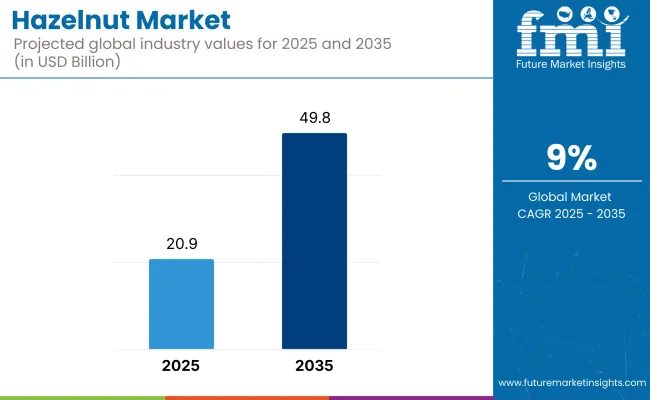
The industry is experiencing constant rise due to the increased need for consumers who are looking for highly nutritious, versatile, and premium quality nuts. Besides growing demand in the confectionery, bakery, dairy, and snack sectors, they are increasingly being incorporated in the production of health foods like plant-based milk alternatives and flavored beverages.
The shift in consumer intentions from snacks high in calories toward nutritious snacks and the use of these snacks in functional food products are the additional aspects that are boosting the industry.
The major factor that boosts this sector is adding them to chocolate products, especially the spreads and pralines. Prominent food makers are making use of them not only for their good taste and texture but for their health advantages too. These products are now ubiquitously used in the production of high-end and handmade chocolates. Simultaneously, the customers who prefer clean-label and less processing reside at the forefront of the organic and ethically sourced supply.
The plant-based and dairy-free food segments are also swimming along the industry current. As nut-based milk options become more popular, hazelnut milk gets more attention as it has no lactose and is rich in nutrients. Likewise, they are being used not only in the making of protein bars, granolas, and energy-boosting snacks but also in plant-based nutrition products.
The new technologies in farming, manufacturing, and storage are paid off through a better taste, more preserved quality, and a longer shelf life. Better tools for harvesting and sustainability-oriented farming principles have been put forward to counter the threats from climate change and variations in crop output. Also, cutting-edge approaches in the production of hazelnut oil and use of flavors have opened up new horizons in food and self-care industries.
On the other hand, the industry has problems like volatile prices, chain broken on the supply side, and susceptibility of production to the atmospheric changes in some major growing areas. Plus, the competition from other tree nuts, with almonds and cashews, may complicate the situation.
Even if there are challenges, there is still a good space for the industry to grow. The rise in the request for organic and Fair Trade hazelnuts plus the soaring consumer knowledge of their health benefits are new opportunities for expansion. Besides, the growth in e-commerce and direct-to-consumer pathways has contributed to the industry development. Furthermore, the shift in consumer preferences which is now increasingly inclined toward healthy and responsibly sourced inputs makes sure that the industry is in for a protracted period of prosperity.
The industry is experiencing high growth due to the factors such as increasing demand in confectionery, bakery, and snack food industries. Customers are turning towards natural and premium ingredients, propelling the application of them in chocolate, spreads, and milk alternatives.
Sustainability is also a major consideration, with companies prioritizing ethical sourcing and organic production. Health-focused consumers are driving the demand for hazelnut-based protein foods and dairy-free milk alternatives, hence making it a top nutraceutical and functional food trend.
Innovation is the driving force, with companies trying out flavored spreads, plant-based milk, and fortified nut blends. Increasingly popular vegan and keto diets are also increasing industry opportunities. Uncertainty in raw material prices and supply chain disruptions are also impacting cost dynamics, and therefore, quality and affordability are critical purchase factors for companies.
The following table shows a comparative evaluation of the six-month variation in the CAGR for the base year (2024) and the current year (2025) for the global industry. Through this analysis, significant changes were seen in the performance and reflected the patterns of revenue realization, thereby enabling stakeholders to have a clearer picture of the growth path throughout the year. The first half-year, or H1, is between the months of January and June. The second half, H2, consists of the months from July to December.
| Particular | Value CAGR |
|---|---|
| H1 | 7.5% (2024 to 2034) |
| H2 | 8.4% (2024 to 2034) |
| H1 | 8.0% (2025 to 2035) |
| H2 | 9.3% (2025 to 2035) |
In the first half (H1) of the decade 2024 to 2035, the industry posted a growth of 7.5% CAGR, followed by a faster growth rate of 8.4% in the second half (H2) of the same decade. Stepping into the next phase, between H1 2025 and H2 2035, the CAGR rose to 8% in the first half and stay significantly high at 9.3% in the second half. During the first half (H1) the industry saw a rise of 20 BPS whereas during the second half (H2), the company saw a fall of 15 BPS.
Between 2020 and 2024, the industry grew steadily, and this was largely fueled by increasing demand for hazelnut-based products by consumers in different industries like confectionery, bakery, and dairy substitutes. During the time, there was a record-high boost in chocolate spread and hazelnut butter sales, particularly in Europe and North America, to which leading companies such as Ferrero and Mondelez International gained through the desire for luxurious and high-quality foods from consumers.
But increased lockdown at-home eating fueled demand for packaged snacks, and increasing appreciation of the healthy properties of hazelnuts-including high levels of healthy fats and antioxidants-elsewhere helped spur industry growth. Advances in technology for processing-such as specialized roasting technology to maximize retention of flavor and nutritional content-also became an important driver behind product differentiation and consumer loyalty.
Between 2025 and 2035, the global industry is expected to gain momentum with strong thrust from technological advancement, shifting consumer preference, and the development of new production regions beyond traditional leaders like Turkey and Italy.
Investments within this period will likely increase as there will be increased development of climate-tolerant varieties for countering risks from the modification of weather patterns and to ensure stable supply chains. Advances in technology in the extraction processes will also drive the production of high-value derivatives such as hazelnut oil for cosmetics and functional food, increasing industry prospects. Premiumization trend will also increase, with consumers calling for single-origin as well as craft products, particularly in the luxury confectionery sector.
Comparative Market Shift Analysis (2020 to 2024 vs. 2025 to 2035)
| 2020 to 2024 | 2025 to 2035 |
|---|---|
| Increased application in confectionery, spreads (e.g., Nutella), and dairy substitutes | Increased use in plant-based foods, functional nutrition, and protein-rich snacks |
| Leadership of Turkey, Italy, and the USA in worldwide production | Diversification with new production centers in Eastern Europe and South America |
| Early transition to sustainable agriculture and organic certification | Global implementation of regenerative agriculture, carbon-neutral cultivation, and AI-assisted precision agriculture |
| Growing application in powders, pastes, and plant-based products | Expansion of fermented products, protein isolates, and plant-based meat substitutes |
| Increased consumer demand for natural and nutrient-dense snacks | Functional products with improved nutritional properties (e.g., probiotics, collagen infusion) |
The industry is living in a difficult crisis caused by the inevitable threats of climate change along with the unpredictable nature of weather patterns. Environmental conditions including droughts, frostbites, and storms that can hit the area in a hard way can considerably affect the yield of the crops, resulting in the supply to the industry being lower than usual and consequently prices become volatile. In order to lessen these risks, the parties involved should invest in climate-adaptive farming practices, in addition to diversifying the selection of regions, and the improvement of the irrigation infrastructure.
Pest infestations and plant diseases, such as bacterial blight and weevil attacks, are concerns for cultivation. Without sufficient pest control and disease management strategies, plants will be out of shape, bringing down the availability in the industry. Employing the integrated pest management technique, the research for the development of resistant crop varieties, and promoting the use of sustainable agricultural practices is the best way to handle these risks.
The growing consumer preferences for organic and the sustainably produced hazelnut also create additional burden for the producers to dismiss or else strictly conform with the certification standards. The farmers have to endure the turmoil of costly endeavors in organic farming and stringent regulatory provisions.
The firms need to find the right equilibrium between cost-returning pursuits and ecological sustainability and they can do so by running green and eco-friendly farming projects as well as obtaining environment-friendly certificates from trusted organizations so as to draw the industry attention to them.
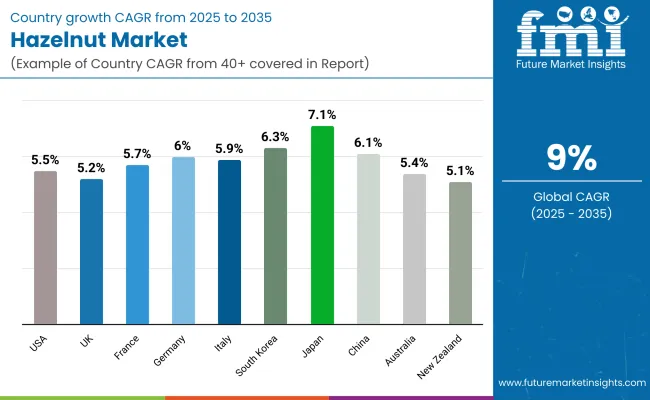
| Countries | CAGR, 2025 to 2035 |
|---|---|
| USA | 5.5% |
| UK | 5.2% |
| France | 5.7% |
| Germany | 6% |
| Italy | 5.9% |
| South Korea | 6.3% |
| Japan | 7.1% |
| China | 6.1% |
| Australia | 5.4% |
| New Zealand | 5.1% |
The USA industry is experiencing strong growth, fueled by ongoing innovations in processing technologies and increasing consumer demand for plant-based and premium nut-based foods. With a deep domestic supply base based in Oregon, manufacturers are taking advantage of precision roasting and micro-grinding technologies to maximize the taste and texture of hazelnut-based products. Demand for ingredients derived from them is growing in dairy alternatives, functional nutrition, and confectionery segments.
Furthermore, premium snacking options like protein bars, nut butter, and gourmet spreads are finding success, reflecting the changing demand for health-aware and convenience-seeking consumers. As the world's largest food manufacturers invest in sustainability and traceability, the inclusion of locally produced them into clean-label food products is additionally driving industry expansion.
The UK industry is seeing consistent growth, supported by rising consumer demand for plant-based, organic, and responsibly sourced ingredients. The growing popularity of flexitarian and vegan diets has resulted in a boom in hazelnut-based dairy substitutes, such as milk, creams, and yogurts.
British bakery and confectionery sectors are also seeing premium demand for premium chocolates, pastries, and spreads. The industry is also gaining from a focus on sustainable supply chains, with businesses increasingly turning towards open-sourcing and fair-trade systems. Moreover, the expanding e-commerce industry is fueling accessibility, enabling smaller specialty brands to access a wider consumer base with direct-to-consumer models.
The French industry is booming because of France's rich tradition in gourmet food and patisserie. Consumers in France have a long-standing affinity for premium, artisanal products, creating greater demand for hazelnut-based spreads, pralines, and pastries.
The premium chocolate segment is especially driving growth, as most top brands include finely ground pastes and roasted whole hazelnuts in luxury confections. In addition, the focus on organic and locally sourced products is promoting the growth of niche product lines for health-conscious buyers. Innovation in applications in high-end culinary and fine dining sectors is also helping in industry growth.
The industry in Germany is marked by dominance in confectionery and special foods, supported by high-value chocolate and baking sectors as lead drivers of expansion. German firms are concentrating on producing small-pack, high-margin hazelnuts based on single-variety roasting technology and origin-tailored purchases. Seasonal sales peak amid celebratory months, especially during holiday seasons, in terms of chocolate fillings in hazelnuts and high-quality gift boxes, thereby fueling growth in the industry.
Moreover, growth in organic and non-GMO certified products is attractive to health-conscious consumers. Equipped with high processing technology, Germany is also leading the innovation in the development of hazelnut pastes, oils as well as finely milled powders for various uses in the kitchen.
Italy is a leading force in the industry, with its worldwide famous production and processing technology. The nation's industry is supported by robust domestic production, especially in the Piedmont and Lazio regions, which provide high-quality varieties to top-end confectionery companies.
Italian produce is a standard feature in the nation's luxury chocolate industry, traditional desserts, and gelato. Single-origin and traceable sourcing is also increasingly solidifying Italy's place in the premium industry. In addition, the use in functional food segments, e.g., protein-fortified snacks and cereals fortified with nutrients, is expanding consumer industries.
The South Korean industry is expanding steadily, fueled by rising demand for Western-style pastries and sweets. The emerging café culture of the country has created a boost in demand for hazelnut-flavored foods and beverages, such as coffee and milk beverages.
Premium and imported confectionery items that include them are also becoming popular among consumers who are indulgence-oriented and prefer high-quality ingredients. South Korean snack food companies are also adding them to energy bars, granolas, and mixtures of nuts so that they can attract health-oriented consumers looking for healthy on-the-go food.
Japan's industry is growing significantly due to increasing interest in gourmet confectionery and fusion foods. Japanese consumers strongly desire high-quality, sophisticated flavors, and hence, hazelnut-enriched pralines, truffles, and upscale desserts are very much in favor. Growth in specialty coffee culture has also translated into higher demand for flavorings and syrups.
The well-being and health trend in Japan has also led to food processors creating hazelnut-enhanced functional snacks and nutritional supplements that meet the demands of aging populations who are looking for antioxidant-based diets.
China's industry is growing with the rising adoption of premium and Western-style snack foods. China's expanding middle class is leading demand for premium chocolates and confectionery, with them being a favored ingredient in premium products. Moreover, the growth of health-oriented consumers is encouraging demand for hazelnut-based protein bars, dairy alternatives, and nut spreads.
Domestic processing facility development is also cutting down on dependence on imports and enhancing supply chain efficiency. E-commerce platforms are also instrumental in popularizing the use of products among Chinese consumers.
Australia's industry is enjoying steady growth, driven by growing consumer interest in gourmet and health-oriented food products. The country's expanding domestic cultivation is enhancing supply chain sustainability alongside enhancing local processing capacity.
Hazelnut-derived dairy alternatives, nut spreads, and protein-rich snacks are going mainstream, fueled by increasing demand for plant-based nutrition. Premium chocolate industries are also capitalizing on high-grade hazelnuts to create distinctive artisanal pieces that resonate with niche consumer tastes.
New Zealand's industry is influenced by the nation's strong emphasis on sustainable and organic food production. With the increased demand for natural and minimally processed foods, hazelnut-derived foods like nut butter, snack bars, and dairy substitutes are in demand.
The specialty confectionery category is also on the upswing, with an increased interest in high-quality, ethically sourced options for upscale chocolates and desserts. Moreover, the rising number of small-scale farms in New Zealand is propelling local production and increasing transparency in the supply chain.
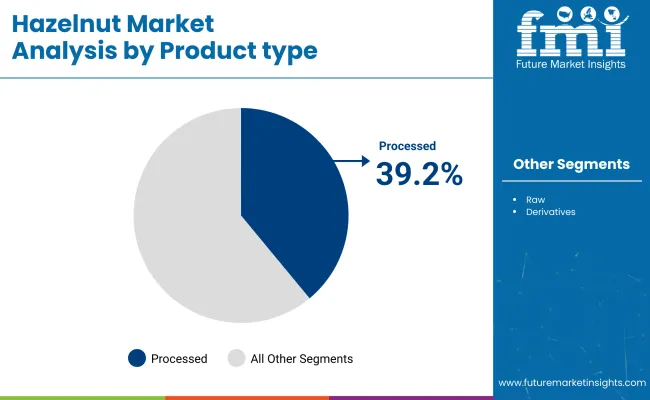
Processed Hazelnuts Driving Global Market Leadership through Indulgence Innovation and Versatile Applications
| Segment | Value Share (2025) |
|---|---|
| Processed Hazelnuts (By Product Type) | 39.2% |
The rising demand in various sectors is expanding. They are estimated to dominate the industry by 2025 with a 39.2% share due to their high consumption of chocolate, bakery, and dairy products. Even big brands still drive demand with new-product innovation: Ferrero, for example, the maker of Nutella, and Mondelez International, the owner of Cadbury. The rise of the plant-based diet has further promoted the popularity of nut milk as an alternative to dairy and its proliferation.
In the global industry, the top product in terms of volume is raw hazelnuts, accounting for 32.5% of the overall industry via direct consumption at home or for industrial processing. They are widely regarded as a healthful food and are therefore being consumed in growing quantities, as they are a source of beneficial fats, vitamins and antioxidants. Two of the world’s top producers-Turkey and Italy-are ramping up their organic farming practices in response to changing consumer preferences, with the organic and non-GMO segments taking off.
The industry is increasingly influenced by sustainability and ethical sourcing. Sustainability has a broader scope than just reducing carbon emissions or waste; it encompasses all aspects of production, and top companies are engaging in responsible sourcing and other sustainability initiatives. For instance, Ferrero is working toward full traceability in its supply chain to fight against deforestation and labor exploitation.
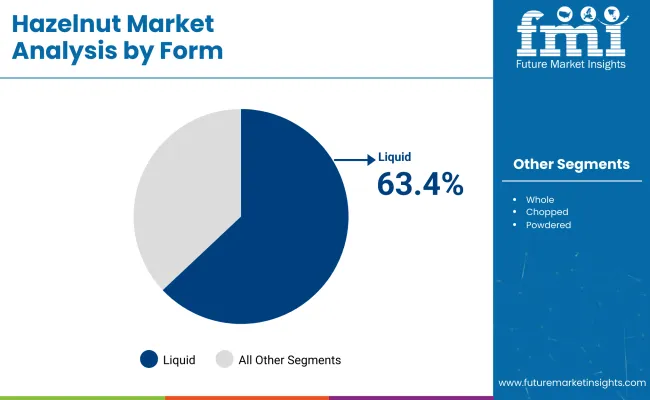
Confectionery and Chocolate Creations Driving the Industry’s Leading Position
| Segment | Value Share (2025) |
|---|---|
| Liquid (Form) | 63.4% |
The industry is witnessing significant growth, driven by increasing consumer demand across the food, cosmetics, and pharmaceutical industries. By 2025, the liquid type (i.e., hazelnut oil) would command a market share of 63.4%. The growing consumption in diverse skin-care and hair-care products owing to its rich antioxidant and moisturizing properties fuel the demand for parts extraction process during the oil extraction process.
Top beauty brands like L’Oréal and The Body Shop include it in the ingredients for anti-aging and hydrating products. It is also being used in gourmet cuisine, especially in European kitchens, where it is utilized as a high-end substitute for other types of vegetable oils.
Now, with an estimated 18.6% share of the industry, raw hazelnuts continue to be a go-to food for health enthusiasts. As consumers become more aware of their heart health and plant-based nutrition, they have found their way into snack mixes, granola, and homemade nut butter. Supermarkets and specialty stores are increasing their selection of organic and non-GMO hazelnuts, with Turkey and Italy as the top-producing countries in the world.
Food companies are focused on sustainability as ethics in sourcing and farming become widespread in the industry. While Ferrero has over a million suppliers, it aims for 100% traceability, ensuring they are produced responsibly. The increasing extraction methods for hazelnut oil and ever-increasing health-conscious consumption are also some of the contributing factors to the industry's growth in the following years.
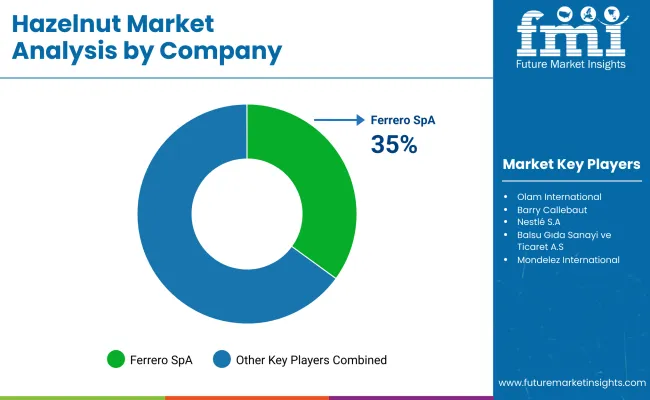
The industry is highly competitive, with vertical integration, strategic sourcing, and value-added processing serving as differentiators among the industry leaders. Ferrero SpA is by far the leader in the marketplace. It takes significant shares of the international supply for its well-known brands, including Nutella, Ferrero Rocher and Kinder Bueno.
This agribusiness major, Olam International, has leveraged such advantages and further fortified its position by establishing a more holistic supply chain, from sourcing to advanced processing. With a state-of-the-art facility presence in Turkey, Olam has become the most preferred partner for global food as well as beverage manufacturers, offering custom solutions for distinct applications.
Barry Callebaut, however, is an international giant in chocolate and cocoa, thereby establishing his stronghold in competition through highly specialized processing and pure seamless integration into its premium confectionery offerings. His focus on traceability, product quality, and sustainability makes it a top choice for the best and most differentiated hazelnut-based formulations.
As consumers increasingly seek natural, sustainably grown, and high-quality options, industries have seen increased investment in ethical sourcing initiatives, new processing technologies, and more specific ingredient solutions. Future competition will be fierce in terms of supply chain resilience, product innovation, and changing consumer preferences for better quality and functional hazelnut-based products.
Market Share Analysis by Company
| Company Name | Estimated Market Share (%) |
|---|---|
| Ferrero SpA | 35-40% |
| Olam International | 18-22% |
| Barry Callebaut | 12-16% |
| Nestlé S.A. | 8-12% |
| Balsu Gıda Sanayi ve Ticaret A.S. | 6-10% |
| Other Companies (Combined) | 15-25% |
| Company Name | Key Offerings/Activities |
|---|---|
| Ferrero SpA | Industry leader with direct sourcing and global processing operations, ensuring supply stability and quality. |
| Olam International | End-to-end processing as well as customized solutions for food manufacturers, with a strong presence in Turkey. |
| Barry Callebaut | Premium chocolate and confectionery formulations with integrated processing and product innovation. |
| Nestlé S.A. | Focuses on hazelnut-infused dairy, confectionery, and snack products with sustainability initiatives. |
| Balsu Gıda Sanayi ve Ticaret A.S. | Leading Turkish exporter specializing in high-quality processed products for global brands. |
Key Company Insights
Ferrero SpA (35-40%)
Ferrero leads the world's industry, utilizing more than 30% of the world's output. Its model is vertically integrated to ensure good quality products; farming operations and processing facilities are directly in the main producing regions like Turkey and South America.
Olam International (18-22%)
Olam is quite well positioned in the global supply chain, offering customized processing solutions to leading food manufacturers. Innovations in Turkey with high-tech processing plants add value to its other offerings and contribute positively to growing its industry share.
Barry Callebaut (12-16%)
Barry Callebaut incorporates them in its high-quality chocolate products and uses knowledge of sustainable sourcing and good-quality processing. The company has increased its visibility in major industries and provides stable supplies of hazelnut-containing products.
Nestlé S.A. (8-12%)
Nestlé enjoys the increasing demand for hazelnut-based dairy and confectionary items. The company's R&D services are oriented toward sustainability and product innovation, which strengthens its competitiveness in the industry.
Balsu Gıda Sanayi ve Ticaret A.S. (6-10%)
Balsu is one of the prime Turkish suppliers, dealing mostly in high-quality processing and value-added solutions. Its compliance with stringent quality standards qualifies it as a leading supplier to major global confectionery brands.
Other Key Players (15-25% Combined)
By product type, the industry is segmented into raw, processed, and derivatives.
By form, the segmentation includes whole, chopped, powdered, and oil.
By application, the industry is categorized into food & beverages, personal care & cosmetics, and pharmaceuticals.
By distribution channel, the industry is divided into business to business and business to consumer.
By region, the industry analysis covers North America, Latin America, Western Europe, Eastern Europe, East Asia, South Asia & Pacific, Central Asia, Russia and Belarus, Balkan & Baltic Countries, and the Middle East & Africa.
The industry is expected to reach USD 20.9 billion in 2025.
The industry is projected to grow to USD 49.8 billion by 2035.
Japan is expected to grow at the fastest rate, with a CAGR of 7.1% during the forecast period.
The processed segment is among the most widely used in the industry.
Leading companies include Mondelez International, Oregon Hazelnuts, Tombul Hazelnut Processing Plant, Ferrero SpA, Olam International, Barry Callebaut, Nestlé S.A., Idilia Foods, Balsu Gıda Sanayi ve Ticaret A.S., and Kanegrade Ltd.






Our Research Products

The "Full Research Suite" delivers actionable market intel, deep dives on markets or technologies, so clients act faster, cut risk, and unlock growth.

The Leaderboard benchmarks and ranks top vendors, classifying them as Established Leaders, Leading Challengers, or Disruptors & Challengers.

Locates where complements amplify value and substitutes erode it, forecasting net impact by horizon

We deliver granular, decision-grade intel: market sizing, 5-year forecasts, pricing, adoption, usage, revenue, and operational KPIs—plus competitor tracking, regulation, and value chains—across 60 countries broadly.

Spot the shifts before they hit your P&L. We track inflection points, adoption curves, pricing moves, and ecosystem plays to show where demand is heading, why it is changing, and what to do next across high-growth markets and disruptive tech

Real-time reads of user behavior. We track shifting priorities, perceptions of today’s and next-gen services, and provider experience, then pace how fast tech moves from trial to adoption, blending buyer, consumer, and channel inputs with social signals (#WhySwitch, #UX).

Partner with our analyst team to build a custom report designed around your business priorities. From analysing market trends to assessing competitors or crafting bespoke datasets, we tailor insights to your needs.
Supplier Intelligence
Discovery & Profiling
Capacity & Footprint
Performance & Risk
Compliance & Governance
Commercial Readiness
Who Supplies Whom
Scorecards & Shortlists
Playbooks & Docs
Category Intelligence
Definition & Scope
Demand & Use Cases
Cost Drivers
Market Structure
Supply Chain Map
Trade & Policy
Operating Norms
Deliverables
Buyer Intelligence
Account Basics
Spend & Scope
Procurement Model
Vendor Requirements
Terms & Policies
Entry Strategy
Pain Points & Triggers
Outputs
Pricing Analysis
Benchmarks
Trends
Should-Cost
Indexation
Landed Cost
Commercial Terms
Deliverables
Brand Analysis
Positioning & Value Prop
Share & Presence
Customer Evidence
Go-to-Market
Digital & Reputation
Compliance & Trust
KPIs & Gaps
Outputs
Full Research Suite comprises of:
Market outlook & trends analysis
Interviews & case studies
Strategic recommendations
Vendor profiles & capabilities analysis
5-year forecasts
8 regions and 60+ country-level data splits
Market segment data splits
12 months of continuous data updates
DELIVERED AS:
PDF EXCEL ONLINE
Hazelnut Milk Market Analysis by Form, End User and Sales Channel Through 2035
Hazelnut Paste Market Analysis – Size, Demand & Industry Trends 2025-2035

Thank you!
You will receive an email from our Business Development Manager. Please be sure to check your SPAM/JUNK folder too.
Chat With
MaRIA